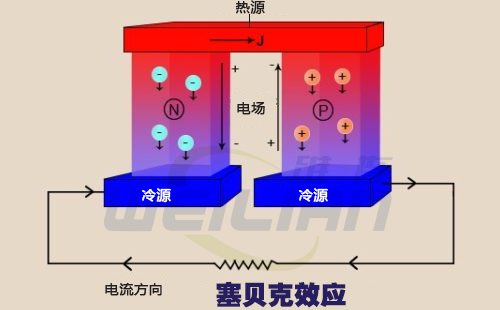
Seebeck effect is one of the three main changes, which can be observed under the thermoelectric effect. It is named after Thomas Johann Seebeck, a German physicist who discovered the thermoelectric effect in his independent research in 1821.
The direct conversion of the temperature difference between two different electrical conductors or semiconductors into electric potential is called thermoelectric effect. When these conductors with potential difference contact through electrical connection, it will cause the flow of charged particles, thus generating current. The opposite case also applies to the case where the temperature difference at the junction of two different electrical conductors will be caused by applying the potential difference on them.
Seebeck effect theory
In Seebeck effect, the same phenomenon will occur, and electric potential will be generated due to the application of heat source. This potential can be measured at the "hot" and "cold" ends of the junction.
Consider the two semiconductors connected to the common heat source, type n and type p, which will increase the temperature at the connection end. The other end of the two semiconductors is at a relatively low temperature, resulting in a thermal gradient. The electrons at the "hot" end of the n-type conductor receive heat energy from the source. They will be energetic and flow to the "cold" end. In this way, the hot end has a low density of charge carriers (n-type is electron, p-type is hole), while the cold end has a high density of charge carriers. This charge distribution forms an electric field on the junction. When a conductor is used to connect the ends of a junction, the charge begins to flow through it and a current is generated.

Three forms of Seebeck effect can be observed.
Connecting the load at both ends will supply power to the load, and these two materials and heat sources will act as generators.
If a voltmeter is connected to both ends with conductors, the measured voltage can be used to determine the temperature difference between the two ends.
Another most common connection is to use a setting as a switch for another electrical setting or circuit to control its operation.
Seebeck generator
The combination of two different conductors connected to the heat source and converted into a voltage to drive the load demand is called a Seebeck generator. It can be used for independent power generation to supply power for small-scale load demand, that is, no external power connection is required. The heat flow from the higher temperature part of the junction to the relatively cold part of the conductor leads to thermal gradients and heat flows. The constituent particles of the junction are charged and begin to move from the high-density region to the low-density region. The voltage difference caused by the charge flow acts as the power source for connecting the load. Since no rotating parts are involved, applications can be found in low-power remote installations.
It is well known that the voltage generated at both ends of a conductor is proportional to the temperature gradient at both ends. The proportional constant is called the thermoelectric potential or Seebeck coefficient. In other words, the change rate of temperature difference and the corresponding change rate of generated voltage are related by Seebeck coefficient.
在数学上,
V = – S(Th – Tl)
Where V=potential difference
S=Seebeck coefficient
Th=hot end
Temperature Tl=cold end temperature
Or,
δ V = – S ( δ T)
Among them, δ V=Voltage
Change δ T=Change in temperature difference
Seebeck coefficient is its standard form, which is defined as the amount of voltage generated between two conductors when the temperature at both ends of the conductor is kept at 1 Kelvin during the whole observation process, that is,
S = – V
Application of Seebeck effect:
There are many mechanical and chemical properties that vary with temperature. Therefore, the Seebeck effect can also be used to study or determine these parameters when monitoring the net change in temperature using the achieved potential. These include testing material strength, degradation, and radiation intensity of radioactive elements over a period of time as a function of temperature. Electrical signals from these thermoelectric devices can be used to activate safety switches or alarms to signal conditions.
Thermocouple——The thermoelectric device is a combination of at least two different conductors or semiconductors for measuring the temperature difference or temperature rise by converting the obtained electrical parameters into their corresponding temperatures. It can also be used to start circuits or valves.
Thermopile –Thermopile is a thermocouple temperature sensor connected in series (sometimes in parallel) to obtain available voltage to provide relatively high power requirements.
High frequency power sensor——Seebeck effect has been found to be able to find the exact amplitude of the sine wave. This helps detect the presence of the overclock power generated in the system and signals it to the operator.
alternator——Combined heat and power generation using Seebeck effect has been proposed and applied by many generator sets to generate additional power by utilizing waste heat generated in industry.
Spin Seebeck effect
Modern scientists have been able to provide another dimension for the study of Seebeck effect by studying the influence of heat exerted on the magnetized electric conductor. The charge carriers driven by thermal gradients are repositioned according to their respective spin or angular momentum. This phenomenon was recently discovered in 2008. Contrary to conventional, there is no waste of heat during particle rearrangement. This effect is widely used to make microswitches with fast response.
The latest development in this field has prompted researchers to try to develop a power supply that uses solar energy and thermoelectric cells at the same time to improve the overall efficiency of the two types of cells, and to use solar radiation as a heat source.

